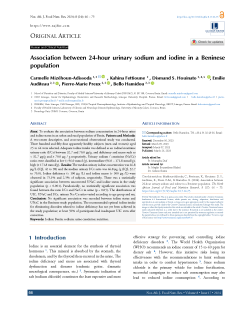Association between 24-hour urinary sodium and iodine in a Beninese population
Abstract
Aims: To evaluate the association between sodium concentration in 24-hour urine and iodine status in an urban and rural population of Benin.
Patients and Methods: A two-center descriptive, and cross-sectional observational study was conducted. Three hundred and fifty-four apparently healthy subjects (men and women) aged 25 to 64 were selected. Adequate iodine intake was defined as an iodine/creatinine urinary ratio (I/Cr) between 32.7 and 70.0 μg/g, and deficiency and excess such as < 32.7 μg/g and ≥ 70.0 μg / g respectively. Urinary sodium / creatinine (Na/Cr) ratios were classified as low (< 96.0 mmol /g), intermediate (96.0 – 171.8 mmol/g), high (≥ 171.8 mmol/g).
Results: The median urinary iodine concentration was 66.8 μg/L (IQI, 42 to 98) and the median urinary I/Cr ratio was 46.8 μg /g (IQI, 32.7 to 70.0). Iodine deficiency (< 100 μg /L) and iodine excess (> 300 μg /L) were observed in 75.1% and 2.5% of subjects, respectively. There was a statistically significant association between uncorrected UNaC and iodine status in the study population (p < 0.001). Paradoxically, no statistically significant association was found between the ratio I/Cr and Na/Cr in urine (p = 0.05). The distributions of UIC, UNaC and I/Cr, urinary Na /Cr ratios varied according to age group and sex.
Conclusion: No significant association was recorded between iodine status and UNaC in the Beninese study population. The recommended optimal iodine intake for eliminating disorders related to iodine deficiency has not yet been achieved in the study population; at least 50% of participants had inadequate UIC even after correction.
Keywords: Iodine; Benin; sodium; urine creatinine; nutrition.
Full text article
Authors
Copyright (c) 2024 Carmelle Mizéhoun-Adissoda, Kahina Fettioune, Dismand S. Houinato, Emilie Auditeau, Pierre-Marie Preux, Bello Hamidou

This work is licensed under a Creative Commons Attribution 4.0 International License.
-
Attribution — You must give appropriate credit, provide a link to the license, and indicate if changes were made. You may do so in any reasonable manner, but not in any way that suggests the licensor endorses you or your use.
-
No additional restrictions — You may not apply legal terms or technological measures that legally restrict others from doing anything the license permits.





